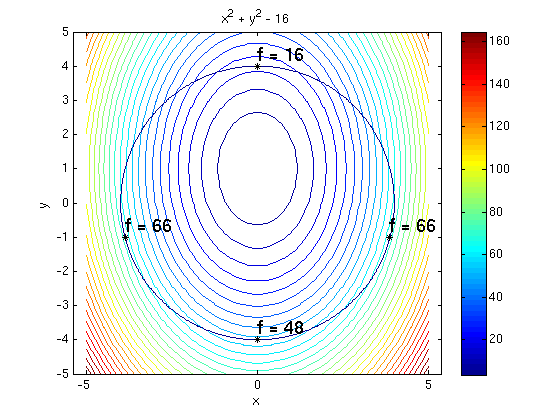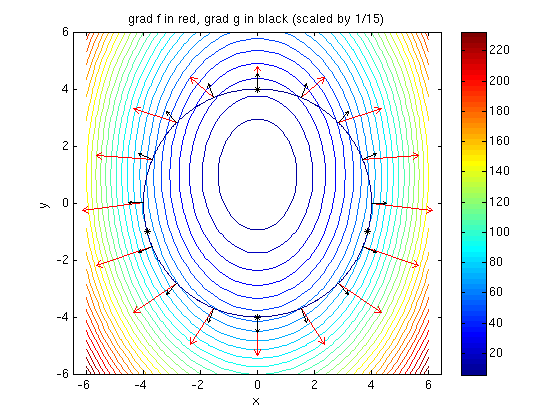Examples Friday, March 14: Lagrange Multipliers
Contents
(a) Find the maximum and the minimum of the function f(x,y)=4*x^2+2*y^2-4*y on the curve given by x^2+y^2=16. Give the value and the location of the maximum and minimum.
Answer: The maximum of the function f on the curve is 66, it is attained at the points (-sqrt(15),-1) and (sqrt(15),1). The minimum of the function f on the curve is 16, it is attained at the point (0,4).
syms x y lambda real f = 4*x^2 + 2*y^2 - 4*y; g = x^2 + y^2 - 16; % we define g(x,y) so that the constraint is g(x,y)=0 fx = diff(f,x) fy = diff(f,y) gx = diff(g,x) gy = diff(g,y) s = solve(fx-lambda*gx,fy-lambda*gy,g,x,y,lambda); % solve the system of 3 equations [s.x,s.y] % s.x is vector of x-values, s.y is vector of y-values % here we get four solutions fs = subs(f,{x,y},{s.x,s.y}) % plug each solution in function f % fs is vector of four function values % Matlab can't find max/min of symbolic values, so we need "double" to convert to machine numbers fsd = double(fs); fmax = max(fsd) % maximum fmin = min(fsd) % minimum ezcontourc(f,[-5,5,-5,5],31); % contour plot of f colorbar; hold on ezplot(g,[-5,5,-5,5]); % plot where g=0 plotpts([s.x,s.y],'k*') % mark critical points with black asterisk for i=1:length(s.x) P = [s.x(i),s.y(i)]; % critical point number i texts(P,sprintf('f = %g',fsd(i)')) % print 'f=...' at each critical point end hold off; axis equal;
fx =
8*x
fy =
4*y - 4
gx =
2*x
gy =
2*y
ans =
[ 0, 4]
[ 0, -4]
[ 15^(1/2), -1]
[ -15^(1/2), -1]
fs =
16
48
66
66
fmax =
66
fmin =
16

(b) Plot the following together:
- the curve given by g(x,y)=c
- the contours of the function f
- the gradient of the function f (in red) and g (in black) for a couple of points on the curve
- the critical points marked by asterisks
Explain how you can see from grad f and grad g in which direction the value of f increases along the curve.
Answer: The vector grad f, projected onto the tangent of the curve, points in the direction where f is increasing along the curve.
The vector w = grad f can be decomposed w = w_par + w_orth where w_par is parallel to grad g, and w_orth is orthogonal on grad g. Then the vector w_orth points in the direction where f is increasing along the curve.
If the vector grad f is parallel to the vector grad g, we have a critical point of the function f on the curve.
ezcontourc(f,[-6,6,-6,6],31); % contour plot of f colorbar; hold on ezplot(g,[-6,6,-6,6]); % plot where g=0 plotpts([s.x,s.y],'k*') % mark critical points with black asterisk for t=(1:16)/16*2*pi % for 16 t-values in [0,2*pi] xt = 4*cos(t); yt = 4*sin(t); gradf = subs([fx,fy],{x,y},{xt,yt}); gradg = subs([gx,gy],{x,y},{xt,yt}); arrow([xt,yt],gradf/15,'r') % we use a factor 1/15 for plotting the gradient vectors arrow([xt,yt],gradg/15,'k') end hold off; axis equal; title('grad f in red, grad g in black (scaled by 1/15)')
